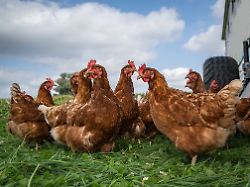Hustle and bustle in the chicken yard
Poultry industry warns of egg shortage
By Martin Morcinek
March 20, 2024, 6:36 p.m
Listen to article
This audio version was artificially generated. More info | Send feedback
Warning signals from the German poultry industry: Shortly before the upcoming Easter holidays, the laying hens association is expecting a seasonal increase in demand for eggs. Will there actually be a shortage of eggs in Germany soon? A look at the official figures.
Year after year, a social phenomenon repeats itself in spring: an everyday food – the chicken egg – turns into a particularly sought-after commodity for a few days at Easter. Easter eggs are an ancient symbol of fertility and life. Shortly before the holidays, millions of Germans resort to cooking, coloring, blowing or hiding the fragile chicken products in large quantities in their own gardens.
The demand for eggs increases as expected before Easter: before the holidays, eggs are “usually a scarce commodity” and that can be observed again this year, explained the general manager of the Central Association of the German Poultry Industry, Wolfgang Schleicher.
In total, around 19.9 billion eggs are consumed in Germany every year, according to the Federal Center for Nutrition (BZfE). According to this information, almost three quarters of the eggs come from Germany, and the “self-sufficiency level” is around 73 percent. The remaining 27 percent are imported: German trade gets eggs from abroad largely from the Netherlands, with smaller shares coming from Poland, Denmark and Belgium.
The vast majority of eggs sold in Germany come from specialized laying hen farms. According to official poultry statistics, commercial chicken farming recently contributed around 13.1 billion eggs to the German egg supply each year. The Federal Statistical Office does not record eggs from small businesses and private chicken farming.
According to official poultry statistics, the demand for organically produced eggs has not increased any further since last year. The market share of organic eggs was most recently 13.4 percent – after 14.2 percent in January 2023. Because smaller chicken farms with fewer than 3,000 laying hens are not statistically recorded, the number of organic eggs sold overall is likely to be higher the BZfE to consider. It is said that many ecologically oriented chicken farmers have fewer than 3,000 animals. “More and more organic farms are relying on mobile chicken farming and direct marketing.”
According to the experts, the most important distinguishing features of organic farming are, in addition to the prescribed exercise and the “lower stocking density” in the stable, above all the feeding with organically produced feed, which can, if possible, be produced on the farm. Pullets begin laying eggs at the age of five months. The hens reach the peak of their laying activity at the age of six to seven months. After 14 months, most chickens have reached the end of their “laying period”. The animals are then eliminated for egg production and are then marketed as soup chickens, for example.
The data from the German poultry statistics show that there are no real bottlenecks in the egg supply in sight this year. The number of eggs produced month after month fluctuates within comparatively narrow limits. The data for 2023/24 shows no noticeable drops. Egg production would naturally be highest in spring. During the so-called moult in winter, chickens – hormonally influenced by the length of daylight and food availability – lay few or no eggs under natural conditions.
In laying hen operations, chicken farmers can adjust with concentrated feed and artificial lighting. Overall, the industry is very well prepared for the seasonal increase before Easter: in recent years, German egg production reached its absolute annual high in March.
The basic supply for consumers is “according to current assessments,” admits the head of the poultry association Schleicher. The laying hen farms are trying to meet the current high demand for eggs.
Eggs could still become scarce on supermarket shelves at times: “It cannot be ruled out that certain product ranges will not be available to the usual extent in Germany for a short time,” warned industry spokesman Schleicher.
Consumers may then have to resort to different sales packaging or a different way of keeping goods. According to the Central Association of the German Poultry Industry, rising prices are also possible due to higher demand. However, a prediction for the period up to Easter is not yet possible.
